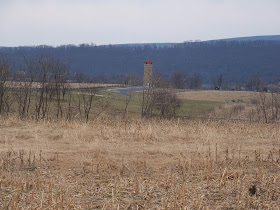As the Sunken Road fighting reached its crescendo in the
noon hour, the Confederate position looked bleak. Israel Richardson’s division had at long last ripped the
center of the Confederate line in the Sunken Road. A Longstreet-inspired counterattack by elements of Colonel
Van H. Manning’s brigade against the Union right flank of the Sunken Road had
been brushed back by Nathan Kimball’s veteran troops. George Greene’s division continued to hold a bridgehead west
of the Hagerstown Pike around the Dunker Church. Further north, two divisions of the Union Sixth Corps were
coming on line. In the center, a
cavalry division with its horse artillery elements clattered across the Middle
Bridge and the gunners opened fire on Cemetery Hill. Fifth Corps infantry lead by Buchanan’s brigade of regulars
inched passed the Newcomer House toward Cemetery Hill along the Boonsboro
Pike. Farther south, Ferraro’s
brigade of the Ninth Corps was launching its ultimately successful assault
against the Lower Bridge as Rodman’s division capture Snavelys Ford. A.P. Hill’s division was somewhere out
there in the direction of Harpers Ferry but its arrival time was unknown.
It was a critical moment but the Federals had problems of
their own. In Richardson’s sector
there was a definite lack of artillery to support a continued attack. First, Second, Sixth and Twelfth Corps
artillery was largely concentrated in the northern area of the
battlefield. Richardson got some
support from the Artillery Reserve across the creek and from Pleasonton’s Horse
Artillery led most famously by John Tidball. These batteries however had other targets that they
were engaging and were not solely dedicated to Richardson. He possessed no artillery under his
direct control until Fitz-John Porter dispatched William Graham’s Battery K, 5th
U.S. Artillery to him late in the morning.
We tend to view the Sunken Road fight on a north-south axis
with French and Richardson pushing south against D.H. Hill’s depleted division
and Richard Anderson’s poorly employed brigades. Richardson and French however had problems on their right
flank which are often overlooked.
As mentioned, Van Manning brigade lead an unsuccessful attack against
the Federal forces along the Mumma Farm Lane. This is one of those actions that get little attention in
the scheme of things at Antietam.
Longstreet is usually remembered for little more than stoically puffing
on a cigar and sporting a red carpet slipper as his staff mans an abandoned gun
from Miller’s battery at Piper’s Orchard.
In fact Longstreet played an active and aggressive role in confronting
this Second Corps attack by orchestrating Manning’s counterattack against
French. Robert E. Lee also
recognized the dire situation and beside sending McLaws and Walker forward, had
taken other measures to shore up defenses in the threatened Confederate center.

West of the Hagerstown Pike south of the Dunker Church is
the Reel Ridge. The ridge is part
of the network of high ground on that side of the road that begins with
Nicodemus Heights, continues south to Hauser’s Ridge and ends as the Reel
Ridge. The ridge is the same
elevation as the ground in the Cornfield and dominates the Sunken Road
position. Throughout the morning,
units of the artillery battalions of the Richard Anderson, D.H. Hill, and John
Walker’s divisions were positioned on the Reel Ridge. All told, 20 guns were positioned on these heights. While eight were the nearly worthless six-pound
and ten pound short-range howitzers, twelve were the much more effective and
longer range 10-pound and 3-inch ordnance rifles. At right angles were 33 more guns in and around the Piper
Farm Lane and on Cemetery Hill.
These 53 guns created a kill zone that it was very difficult for
Richardson to counter. William Graham’s six Napoleons were woefully outranged
and outgunned, as he would relate in his official report. Our tendency to look only at the
activities east of the Hagerstown Pike can cause us to overlook the critical
role played by the Confederate artillery west of the Pike.
 |
| Looking east from the Reel Ridge toward Sunken Road |
 |
| Zoom in of Sunken Road from Reel Ridge |
These pictures shows this very clearly. Taken today during a ranger-lead hike
along the Reel Ridge, we can clearly see the Sunken Road and Observation Tower
spread out before us. Slightly to
the left of the Observation Tower would have been the location of Graham’s
Napoleons. On the Carmen-Copes map
of 12 o’clock we see the enfilading fire that the Confederate guns were capable
of levying on Richardson’s advancing forces. It is very possible that one of these guns on the Reel Ridge
mortally wounded the aggressive Richardson and halted the Union drive over the
nearly prostrate Confederate center.
Things would not go well for the Union on other
sectors. The Sixth Corps never
went into action. Greene’s
division pulled back from its Dunker Church salient after running low on
ammunition. Syke’s regulars were
halted short of Cemetery Hill and the Ninth Corp’s forward motion after its successful
capture of the Lower Bridge stalled until fresh troops from Orlando Willcox’s
division were brought forward to continue the advance. So much time ensued that A.P. Hill’s
division was able to arrive and halt Burnside’s final attack toward Sharpsburg.
A key to the Confederate success in denying the Army of the
Potomac a decisive tactical battlefield victory on September 17th
lay in Lee and Longstreet’s efforts in the center. Skillful use of the terrain advantages gained by positioning
artillery batteries on the Reel Ridge was instrumental. The next time you visit Antietam, go to
the Sunken Road and look west at the important Reel Ridge position. You will appreciate the importance of
that key terrain just as Lee, Longstreet (and I dare say Richardson) did.

No comments:
Post a Comment